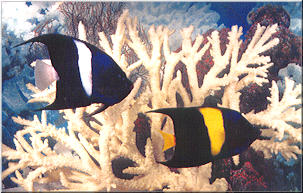Asfur AngelfishThe Asfur Angelfish (Arusetta asfur) is an inhabitant of the Red Sea and can be found in certain parts of the adjacent Gulf of Aden. The marine fauna of the Red Sea is unique. No more that 10% of the known fishes are confined as species or sub-species to the Red Sea. There are still to be discovered as more searchers visit and dive in the area. International Report: Red Sea. The Asfur angel, once identified as Pomocanthus Asfur has officially been classified as Arusetta Asfur. In nature this species is moderately common around semi-protected inshore reefs characterized by rich growths of soft and hard corals. In the wild the Asfur likes caves, crevices or rocky places with plenty of protection. Occasionally, the Asfur can be seen swimming around for brief periods when looking for food. It can be found depths from 10-45 feet (3-15 meters). It is not easy to collect this exotic beauty. The Asfur has a unique character. It is very cautious and enjoys water with temperatures of about 78°F – 84°F (26°C – 29°C). The Asfur can change its living place according to the seasons and availability of foods. The juvenile stage is similar to that of Pomocanthus maculosus which also occurs in the Red Sea, Arabian Sea and Arabian Gulf. However, the tail of the Asfur is yellow instead of white as in P. maculosus. The juvenile Asfur has a streak of yellow or gold extending from the middle of the side onto the soft dorsal fin. In the wild the Asfur reaches a maximum size of about 16″ (40cm). This species seldom grows more than 9″ (22cm) in captivity. In the home marine aquarium the Asfur angel is shy, but with a little patience can be easily tamed. In captivity it will eagerly accept a variety of healthy foods. Ideal foods to offer the Asfur are fresh shrimp or squid. The Asfur will also accept high quality frozen foods such as lance fish or foods with sponge. It would be best to mix a liquid vitamin additive such as MARINE VITA-PEP™ and/or Coral Reef & Marine Fish Vitamins™ with these or other fresh, frozen or quality flake foods periodically. In captivity, the Asfur can be very aggressive towards its own species. One way to keep more than one Asfur in your aquarium is to introduce Asfurs that are dramatically different in size. This way the Asfurs with not threaten each other when feeding or securing their own hiding places. No matter the size or numbers of the Asfur in the home aquarium, it is most important to offer multiple hiding places for each fish kept. According to Dr. Allen’s book, Butterfly and Angelfish of the World, Vol. 2, the juvenile Asfur has the same basic shape as when it is adult. However, the juvenile Asfur has a white mid-band that develops into a brilliant yellow or gold when adult. When the Asfur reaches a length of about 3 inches (7.5 cm) the adult color is fully developed. The Asfur starts developing a full body with trailer fins before other types of angelfish. The Asfur and other fish and invertebrates from the Red Sea are considered highly prized aquarium pets. However, due to the seasonal availability of certain species, high temperatures in the summer months, and the political instability of the area, these animals may not be available all year round. If you are fortunate enough to find a healthy Asfur angelfish that is taking a variety of foods, the price may appear costly. However, the Asfur angelfish will become one of your most prized aquarium pets. A future issue of MARINE AQUARIST™ will feature an article with photos that describe the differences between the yellow or golden banded Asfur, white banded Asfur and P. maculosus angelfish. |
